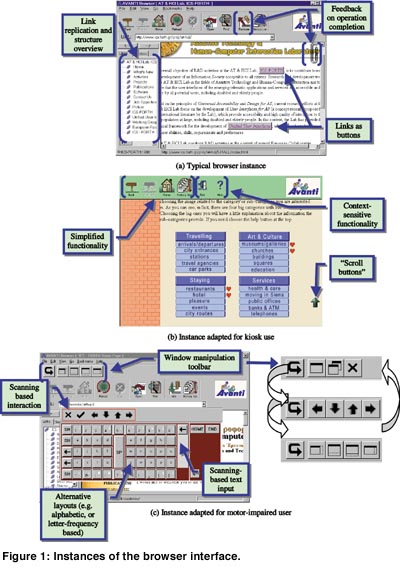

by Constantine Stephanidis
The AVANTI Web browser aims to facilitate access to Web-based information sources, applications and services, by potentially all categories of end users (including people with special needs), in different contexts of use.
The design space for the AVANTI Web browser was large and necessitated a move away from traditional user interface development approaches, which cannot cater for the foreseen levels of diversity and variability in the target user population and contexts of use. The novel Unified User Interface Development method was adopted in order to support the practical application of the concepts and principles of ‘User Interfaces for All’ during the user interface development life cycle. Unified User Interfaces address the individual requirements of potentially all users in different contexts of use, by employing self-adaptation, to cater for their diverse, and often dynamically changing, characteristics. Self-adaptation in the AVANTI browser is based on user (dis)abilities, skills and knowledge, requirements and preferences, as well as the characteristics of the context of use. Adaptations in the browser take place during the initiation of interaction (adaptability), as well as at run-time (adaptivity).

Two instances of the interface that demonstrate adaptation based on the characteristics of the user and the usage context are presented in Figure 1(a) and Figure 1(b). Specifically, Figure 1(a), presents a typical instance intended for use by a user familiar with Web browsing. Note the additional functionality that is available to the user (eg, a pane where the user can access an overview of the document itself, or of the links contained therein, an edit field for entering the URLs of local or remote HTML documents), as well as the facilitation of the link selection (links are presented as buttons, arguably increasing their affordance).
The second instance, Figure 1(b), presents the interface in ‘kiosk mode’, ie, making use of the kiosk-based information system metaphor. Note that the typical windowing paradigm is abandoned and replaced by a simpler, content oriented interface (for example, scrollbars have been replaced by ‘scroll buttons’, which perform the same function as scrollbars, but have different presentation and behavioral attributes – eg, they ‘hide’ themselves if they are not selectable). Furthermore, the interface ‘toolbar’ contains ‘content-sensitive’ buttons, ie, buttons which differ based on the actual information content of the pages being viewed.
Figure 1(c), presents disability-oriented adaptations in the browser’s interface. The interface is presented with automatic scanning activated. The additional toolbar that was automatically added in the user interface is a ‘window manipulation’ toolbar, containing three sets of controls enabling the user to perform typical actions on the browser’s window (eg, resizing and moving). The three sets of controls, as well as the ‘rotation’ sequence between the sets are also depicted on Figure 1(c). These sets occupy the same space on the toolbar, to better utilize screen real estate, and to speed up interaction; the user can switch between them by selecting the first of the controls. In the same figure one can also see the on-screen, ‘virtual’ keyboard activated for text input (interaction with the keyboard is also scanning-based), as well as the scanning highlighter over the toolbar on the screen keyboard that provides feedback on the current selectable item.
Run-time adaptations in the AVANTI Web browser aim to enhance the quality of interaction by providing real-time support and guidance to the user as he/she interacts with the system. The system monitors the interaction session, identifies possible interaction gaps and triggers the activation of appropriate dialog patterns or interface adaptations. The different categories of run-time adaptations include the provision of awareness prompting, adaptive guidance and help facilities, and the activation of alternative interaction patterns for each browser task.
The AVANTI Web browser prototype, developed by ICS-FORTH, is currently the only system known to provide access to the Web for a range of user categories and different contexts of use. Ongoing work involves the support of different platforms and different terminal devices, as well as the compliance to new guidelines and recommendations for User Agents and Web Content Accessibility.
The AVANTI consortium, partly funded by the ACTS Programme of the European Commission, comprised: ALCATEL Siette (Italy) - Prime contractor; CNR-IROE (Italy); ICS-FORTH (Greece); GMD (Germany); University of Sienna (Italy); MA Systems (UK); MATHEMA (Italy); VTT (Finland); ECG (Italy); University of Linz (Austria); TELECOM ITALIA (Italy); EUROGICIEL (France).
Please contact:
Constantine Stephanidis - ICS-FORTH
Tel: +30 81 391741
E-mail: cs@ics.forth.gr